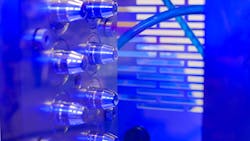Molding for low-volume parts, also defined as prototype casting or bridge casting, is a rapid and cost-effective method of producing a range of plastic parts in a short time. When you create aluminum, steel and plastic molds using rapid injection tooling, you can further utilize them to make multiple copies of parts.
Manufacturers produce these parts within just 2-5 weeks using rapid injection molding techniques. Rapid tooling is used to create molded parts for rapid prototyping needs in a shortened period. The use of high-quality molded parts lengthens tooling life, reduces manufacturing errors and even reduces the total costs.
Some injection molding manufacturing companies can create a bridge tooling to test the manufacturing prototypes using rapid injection tooling. It will save a significant amount of time and evaluate the products to be achieved. Once you have created the bridge tooling, you can manufacture thousands of prototypes using rapid injection molding.
Rapid injection molding can be used to create large batches of parts and make small sets of prototypes based on the parts that you are required, tool life and molding process parameters. Rapid injection molding is a leading technique that combines conventional injection molding for mass production and rapid tooling techniques; it is more than just speed and cost, but about the capability to deliver a product that meets your desired results.
When using rapid tooling for manufacturing parts of your development process, you should consider the following things:
Advanced DFM
Design for manufacturability (DFM) is a blend of techniques that allows you to consider your specific product and business objectives, including authenticity, regulatory requirements, cost and supply chain. To choose the right manufacturing technology that meets your needs, you must evaluate each technology’s costs, timeline and product output abilities.
You should have the experience to choose the right DFM for plastic molded parts and prototype tooling because it is important to choose every aspect of the part correctly. It includes gate type and location, draft, runner system parting line, slide and inserts, etc.
In the early design stage, DFM reduces the manufacturing problems of the plastic molded parts that lower the lead time for the part.
Choosing the Right Materials
Choosing the right material for rapid prototyping is a complex but important task in your project that impacts everything from device performance to test and sterilization methods, cost, profitability and product life. When designing a new device, the manufacturers prefer to use materials based on strength, cost, design, performance, complexity and manufacturability. The shrink rate of the material is also an important factor that you should consider when determining the manufacturing process, as every factor influences the other material concerns.
Cost-Effective Manufacturing Process
Rapid injection molds are very expensive and increase the cost of change. Therefore, you should use MUD (master unit dies) to meet the customers' requirements and reduce the costs because engineering design and the cooperation between both the customers and the manufacturers are the two essential points that ensure a successful production.
MUD is used to change injection mold design faster; you can decrease the number of prototype components using MUD systems if the invention has been changed for the first batch.
Validation Of Components
Usually, you should be cautious in considering the validation criteria for your parts early in the development process. It is very complex to decide whether to validate a component or the whole assembly of a device; the decision is risky and based on the criticality of the device plus your FMEA (failure modes and effect analysis).
If the use of products does not need validation for component delivery of the same tool, in this situation, some certain trade-offs can speed up the development process. Knowing the intentional use of components allows your tool designer to offer trade-offs to lower the cost and speed delivery.
Number of Parts
Understanding the number of parts allows your manufacturing partner to put on tooling investment suitable for the life of the tool and other technologies that might be a better fit. Aside from that, every technology has a tipping point where the total cost of ownership becomes a limiting issue.
Conclusion
Rapid injection molding is the best option for your next project because it offers a rapid manufacturing time that can save your development time and investment capital. It can produce large batches of world-class prototypes in the manufacturing development phase using rapid injection tooling in just a few weeks. Optimizing the tool structure before the final parts meet your production quality needs has several complexities.
About the Author
John Rich
John Rich is a Web Developer & SEO expert. He is working in the SEO IT Group anhave years of experience in creating content for multiple websites






